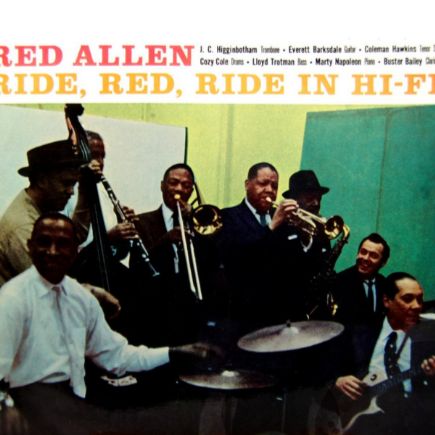I Cover the Waterfront: une ballade au souffle intemporel
Composée en 1933 par Johnny Green, sur des paroles d’Edward Heyman, I Cover the Waterfront a été inspirée par le roman éponyme de Max Miller — un journaliste qui couvrait les docks californiens à la recherche de scandales et de scoops — et son adaptation cinématographique. La chanson capture l’attente, le désir et la mélancolie d’un amour absent, sur fond de rivage et d’horizons incertains.
Malheureusement, lorsque I Cover the Waterfront a été incluse dans le film éponyme de 1933 (avec Ben Lyon et Claudette Colbert), seule la partie instrumentale a été retenue, laissant de côté toute la magie des paroles. La chanson a été un succès dans la version originale de Joe Haymes et Eddy Duchin, et on peut également l’entendre sur le film d’un concert donné par Louis Armstrong à Copenhague en 1933.
Musicalement, le morceau repose sur une structure classique, mais laisse une grande liberté expressive aux interprètes. Les ralentis, les suspensions, les modulations subtiles donnent à chaque version une couleur particulière. Le texte, empreint de lyrisme romantique, évoque la solitude du narrateur face à l’attente de l’être aimé, scrutant le rivage dans l’espoir d’un retour.
Henri Red Allen: tradition et modernité dans un souffle de velours
Le 27 mars 1957, Henri ‘Red’ Allen enregistre une version remarquable de I Cover the Waterfront pour l’album Ride, Red, Ride in Hi-Fi, entouré d’un ensemble prestigieux: Coleman Hawkins au saxophone ténor, J.J. Higginbotham au trombone, Buster Bailey à la clarinette, Marty Napoleon au piano, Everett Barksdale à la guitare, Lloyd Trotman à la basse et Cozy Cole à la batterie. Ce casting d’exception reflète l’ambition de l’album et la place singulière d’Allen dans le jazz de l’après-guerre.
À cette époque, Red Allen est en pleine maturité artistique. Trompettiste issu de la tradition New Orleans, il réussit ici un équilibre subtil entre fidélité stylistique et ouverture aux évolutions du jazz moderne. Dans cet enregistrement, il démontre une capacité rare à inscrire la tradition dans une perspective résolument contemporaine, au moment même où swing, bebop et hard bop commencent à converger dans un langage plus libre et expressif.
L’arrangement choisi pour I Cover the Waterfront illustre cette finesse d’approche. La trompette d’Allen entre avec un timbre feutré, presque introspectif, exposant la mélodie avec une retenue élégante. Son phrasé souple et nuancé joue avec le temps, réinvente chaque courbe de la ligne mélodique, tout en conservant la chaleur et la générosité de son style. L’influence des grandes ballades swing y est palpable, notamment dans la richesse harmonique et l’équilibre entre structure et liberté d’interprétation.
I Cover the Waterfront: una balada de aliento atemporal
Compuesta en 1933 por Johnny Green, con letra de Edward Heyman, I Cover the Waterfront se inspiró en la novela homónima de Max Miller —un periodista que cubría los muelles de California en busca de escándalos y primicias— y en su adaptación cinematográfica. La canción capta la espera, el deseo y la melancolía de un amor ausente, enmarcados en un paisaje de costa y horizontes inciertos.
Lamentablemente, cuando I Cover the Waterfront fue incluida en la película homónima de 1933 (protagonizada por Ben Lyon y Claudette Colbert), solo se utilizó su parte instrumental, dejando de lado toda la magia poética de la letra. La canción tuvo éxito en la versión original de Joe Haymes y Eddy Duchin, y también puede escucharse en la filmación de un concierto de Louis Armstrong en Copenhague en 1933.
Desde el punto de vista musical, la pieza se basa en una estructura clásica, pero ofrece una gran libertad expresiva a quienes la interpretan. Las ralentizaciones, las pausas y las sutiles modulaciones confieren a cada versión un carácter único. La letra, impregnada de lirismo romántico, evoca la soledad del narrador que espera, desde la orilla, el regreso de su ser amado.
Henri Red Allen: tradición y modernidad en un soplo de terciopelo
El 27 de marzo de 1957, Henri ‘Red’ Allen graba una versión notable de I Cover the Waterfront para el album Ride, Red, Ride in Hi-Fi, acompañado por un conjunto de primer nivel: Coleman Hawkins al saxofón tenor, J.J. Higginbotham al trombón, Buster Bailey al clarinete, Marty Napoleon al piano, Everett Barksdale a la guitarra, Lloyd Trotman al contrabajo y Cozy Cole a la batería. Esta formación excepcional refleja tanto la ambición del disco como el lugar único que ocupa Allen en el jazz de la posguerra.
En aquel momento, Red Allen atraviesa una etapa de plena madurez artística. Trompetista arraigado en la tradición de New Orleans, logra aquí un equilibrio sutil entre fidelidad estilística y apertura a las nuevas corrientes del jazz moderno. Esta grabación demuestra su capacidad poco común para inscribir la tradición en una perspectiva contemporánea, justo en el momento en que swing, bebop y hard bop empiezan a converger en un lenguaje más libre y expresivo.
El arreglo elegido para I Cover the Waterfront revela toda su sutileza. La trompeta de Allen entra con un tono aterciopelado, casi introspectivo, exponiendo la melodía con una elegancia contenida. Su fraseo, fluido y matizado, juega con el tiempo y reimagina cada curva melódica, manteniendo al mismo tiempo la calidez y generosidad características de su estilo. Se percibe también la influencia de las grandes baladas del swing, en la riqueza armónica y en el equilibrio entre estructura y libertad interpretativa.
I Cover the Waterfront: una ballata dal respiro senza tempo
Composta nel 1933 da Johnny Green, con testo di Edward Heyman, I Cover the Waterfront trae ispirazione dal romanzo omonimo di Max Miller — un giornalista che frequentava i moli della California alla ricerca di scandali e notizie sensazionali — e dalla sua trasposizione cinematografica. La canzone cattura l’attesa, il desiderio e la malinconia di un amore lontano, sullo sfondo di una riva e di orizzonti incerti.
Purtroppo, quando I Cover the Waterfront venne inclusa nel film omonimo del 1933 (con Ben Lyon e Claudette Colbert), ne fu utilizzata soltanto la parte strumentale, tralasciando tutta la magia del testo. La canzone riscosse successo nella versione originale di Joe Haymes ed Eddy Duchin, e si può ascoltare anche nella registrazione di un concerto di Louis Armstrong a Copenaghen nello stesso anno.
Musicalmente, il brano si basa su una struttura classica, ma lascia ampio spazio all’espressività dell’interprete. Rallentamenti, sospensioni e modulazioni sottili conferiscono a ogni versione una sfumatura distinta. Il testo, pervaso da lirismo romantico, evoca la solitudine del narratore che scruta la riva in attesa del ritorno della persona amata.
Henri Red Allen: tradizione e modernità in un soffio di velluto
Il 27 marzo 1957, Henri ‘Red’ Allen registra una memorabile versione di I Cover the Waterfront per l’album Ride, Red, Ride in Hi-Fi, circondato da un ensemble d’eccezione: Coleman Hawkins al sax tenore, J.J. Higginbotham al trombone, Buster Bailey al clarinetto, Marty Napoleon al pianoforte, Everett Barksdale alla chitarra, Lloyd Trotman al contrabbasso e Cozy Cole alla batteria. Questa formazione stellare riflette l’ambizione del progetto e la posizione unica di Allen nel jazz del dopoguerra.
In quel periodo, Red Allen è all’apice della maturità artistica. Trombettista profondamente legato alla tradizione di New Orleans, riesce qui a coniugare con finezza la fedeltà stilistica con una forte apertura verso le nuove tendenze del jazz moderno. Questa registrazione dimostra la sua rara capacità di inserire la tradizione in una prospettiva contemporanea, proprio mentre swing, bebop e hard bop iniziano a fondersi in un linguaggio più libero e articolato.
L’arrangiamento scelto per I Cover the Waterfront rivela una straordinaria sensibilità. La tromba di Allen entra con un timbro morbido, quasi introspettivo, e presenta la melodia con una grazia misurata. Il suo fraseggio, fluido e sfumato, gioca con il tempo reinventando ogni curva della linea melodica, mantenendo al contempo il calore e la generosità che caratterizzano il suo stile. L’influenza delle grandi ballad dello swing è evidente nella ricchezza armonica e nell’equilibrio tra forma e libertà espressiva.
I Cover the Waterfront: a ballad with timeless breath
Composed in 1933 by Johnny Green with lyrics by Edward Heyman, I Cover the Waterfront was inspired by Max Miller’s novel of the same name — written by a journalist who roamed the California docks in search of scandals and scoops — and its film adaptation. The song captures the longing, desire, and melancholy of a distant love, set against a backdrop of shorelines and uncertain horizons.
Unfortunately, when I Cover the Waterfront was featured in the 1933 film of the same name (starring Ben Lyon and Claudette Colbert), only the instrumental version was included, leaving out the lyrical magic of the original. The song found early success in the versions by Joe Haymes and Eddy Duchin, and it can also be heard in a filmed 1933 concert by Louis Armstrong in Copenhagen.
Musically, the piece is built on a classic structure, yet offers performers significant expressive freedom. Slowdowns, suspensions, and subtle modulations give each rendition a distinct character. The lyrics, steeped in romantic lyricism, evoke the narrator’s solitude as they scan the waterfront, hoping for a loved one’s return.
Henri Red Allen: tradition and modernity in a velvet breath
On March 27, 1957, Henri ‘Red’ Allen recorded a striking version of I Cover the Waterfront for the album Ride, Red, Ride in Hi-Fi, accompanied by an all-star ensemble: Coleman Hawkins on tenor saxophone, J.J. Higginbotham on trombone, Buster Bailey on clarinet, Marty Napoleon on piano, Everett Barksdale on guitar, Lloyd Trotman on bass, and Cozy Cole on drums. This exceptional lineup reflects both the ambition of the recording and Allen’s singular status in postwar jazz.
At that point in his career, Red Allen was in full artistic maturity. A trumpeter rooted in the New Orleans tradition, he achieved a delicate balance between stylistic fidelity and openness to modern developments. This recording showcases his rare ability to place tradition within a contemporary framework, at a time when swing, bebop, and early hard bop were beginning to merge into a freer, more expressive language.
The arrangement chosen for I Cover the Waterfront highlights Allen’s subtlety. His trumpet enters with a velvety, almost introspective tone, presenting the melody with elegant restraint. His phrasing — supple and nuanced — plays with time, reshaping each melodic contour while preserving the warmth and generosity of his style. The influence of classic swing ballads is evident in the harmonic richness and the careful balance between structure and interpretive freedom.


